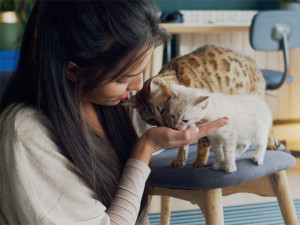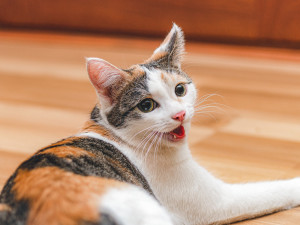Why Does My Cat Stare at Me?
...Is it something you said?

Share Article
In This Article:
Reading Cat Facial Cues and Expressionsopens in a new tab Common Reasons Cats Stareopens in a new tab When Staring Becomes Problematicopens in a new tab Frequently Asked Questionsopens in a new tab
There you are, minding your own business, when you notice out of the corner of your eye your cat — glaring at you with the fire of a thousand suns. Apparently, no one told cats it’s rude to stare. Don’t be offended. Your cat could be trying to get your attention or show affection (albeit in a creepy way).
Cats have enviable vision, especially in the dark, which is why they are such prolific little predators. But you already knew that. What you might not know is that they’re also a bit near-sighted, which might explain why they like to get all up in your face to stare at you. Whether they just want to get a closer look at your face or they’re trying to tell you that’s something’s off, let’s uncover all the reasons behind those piercing glares.

littleKin™ is Kinship’s home just for puppy and kitten parents. Bop over to check out expert advice, new pet tools, and special deals—all curated for your newest family member.
opens in a new tabReading cat facial cues and expressions
If you can’t figure out why your cat is staring at you, pay closer attention to their body languageopens in a new tab. From their eyes and ears to their tails and torsos, cats use body language to try to communicate with us.
“The cat’s pupils can tell you a lot about how distressed they are when they are staring,” says Joey Lusvardi, a certified cat behavior consultant at Class Act Catsopens in a new tab. “A relaxed cat will have thin, almond shaped pupils. A cat that is anxious, fearful, or stressed will have wider, dilated pupils.”
Lusvardi explains that pupil size is also affected by light, so if you notice your cat’s pupils are bigger while in a low light setting, it may not be cause for concern, but it’s a good idea to be cautious if you’re not sure.
Aside from their eyes, their ear position can also tell you a lot about how they’re feeling. If the cat’s ears are facing the sides or pinned back, that’s a sign that your feline is not happy. When combined with a stare, it’s definitely an “approach at your own risk” type situation. Actually, don’t approach — your cat likely needs space.
Lastly, be aware of any vocalizations that accompany those glaring eyes. Growling and hissingopens in a new tab are ones to keep your ears peeled for specifically.
“Growls are not a good sign and the cat is trying to warn whatever is causing them to feel unsafe that they need to back off,” Lusvardi explains. “Hissing is not a great vocalization, but it’s not as bad as a growl. Hissing indicates the cat feels threatened and is telling you to back off. If you notice a cat staring at you and you get hissed at, give them space, as they’re feeling nervous.”
Common reasons why cats stare
Now that we know a little bit more about how our feline friends communicate, it’s time to understand what circumstances lead to these body language cues. Here are the most common reasons why cats stare.
They’re trying to get your attention.
A stare could be a sign that your cat is simply trying to get your attention. For example, you may notice your cat staring at you when it’s coming up on mealtime. If you’re running a few minutes late, they’ll move a bit closer and lower their gaze. And if you still don’t dutifully fill their bowl, your cat might just paw something off the counter. Now they’ve got your attention. Whether it’s about mealtime, long-overdue playtime, or some much-needed pets, maybe your cat is just gently nudging you to pay attention to them.
They’re showing affection.
As much as some cats try to act like they don’t want our affection, they do. Those soulful stares may just be their way of saying, “Love on me, please!” Especially if your cat is doing the “ slow blinkopens in a new tab.”
“Of course, sometimes staring can be a good sign,” Lusvard says. “Cats that stare while slowly closing their eyes and opening them again, often called the ‘slow blink’, are communicating that they’re not a threat. It’s an affectionate behavior that shows your cat doesn’t feel threatened by you and wants you to know they trust you. A cat looking away briefly and turning back to look at you, especially if accompanied by a slow blink, is usually a sign of a comfortable cat. While they may appear like they are staring, those brief looks away are a key difference between a threatening, distressed stare and a sign of affection.”
They’re establishing dominance.
While this is rare in happy cat-human relationships, a particularly creepy stare might be a cat’s way of letting you know they’re in charge (aren’t they all, though?). This may be accompanied by other aggressive behaviorsopens in a new tab, and they’ll typically do this until you look away. It’s just your occasional reminder that cats are some of the world’s most efficient predators. And in this case, it’s best to refrain from engaging in a staring contest and slowly move away.
They’re curious.
We’ve all stared at someone or something just because we were curious — and cats are no different. They may be wondering what that delicious snack is in your hand, or why you cut your own bangs, or how you’ve managed to stay in your PJs all day (cats can be a little judgyopens in a new tab, but who isn’t?). Staring for the sake of curiosity is common especially in young and energetic cats. Sometimes they just want to see what you’re up to and observe all the weird things you do.
They’re fearful.
It’s kind of sad to think about, but your cat may also stare at you if they’re fearful. That kind of stare would likely be accompanied by a hunched body posture and tucked tail. This is also when you’ll probably notice their pupils dilate in defense.
“If a cat is staring at another cat or a person they’re unfamiliar with, they’re probably afraid or feel threatened, so they’re trying to evaluate the threat,” Lusvardi explains.
They’re in pain.
Persistent starting could also mean your cat’s feeling out of sorts. Cats are pretty stoic when in pain (it’s a survival mechanism), but they may squint or appear to stare into the void. Are they looking at you? Past you? It goes back to learning their body language: a stiff or obviously pained posture might signal it’s time to call the vet.
When cat staring becomes problematic
Cat staring can certainly be innocent, but there are times when it shifts from, “Aw, my cat thinks I’m pretty!,” to “Should I run and hide?” There are also times when you’re not at risk, but your cat is, whether it’s due to an underlying medical issue or a perceived threat they’re facing.
“The longer a cat is staring, the more concerned one should be,” Lusvardi says. “Usually cats will break a stare within a few seconds.”
Lusvardi explains that cat behavior should always be interpreted in the context of the cat’s overall body language and the situation the cat is in. If the stare is paired with aggressive body language or you notice other signs that they may be in pain, it’s time to call in the pros. A veterinarian or animal behaviorist can help you get to the bottom of the persistent glares and get your feline friend back on track.
FAQs (People also ask):
Why does my cat stare at me when I sleep?
A cat may stare at you when you sleep opens in a new tabfor a few reasons. They may be expressing affection, feeling bored, or just simply keeping an eye on you. Staring at you may also indicate anxiety or stress. Your cat could also be trying to get your attention, whether they think their dinner portion was a little underwhelming or they didn’t get quite enough stimulation during the day.
Why does my cat stare at me without blinking?
A slow blink from your cat can be a sign of affection and trust. They might be feeling very relaxed and content opens in a new tabin your presence. Cats don’t blink as much as us, and a slow, unflinching stare isn’t necessarily a sign of aggression. In fact, it could be quite the opposite.
Why doesn’t my cat blink?
While you may not think your cat is blinking, they probably are. Cats don’t need to blink as frequently as humans because they have a third eyelid, called a nictitating membrane. This thin membrane flicks across their eye to spread tears and remove dust, all very quickly. So, it might look like your cat isn’t blinking at all, but they’re actually keeping their eyes lubricated and clean in a different way.
How do cats communicate?
Cats communicate through vocalizations and body language. They meow, purr, chirp, and hiss to express emotions such as happiness, annoyance, or hunger. But their body language is just as important. A swishing tail can mean anything from curiosity to agitation, while relaxed ears and a purr usually signal contentment. They even use scent to communicate, rubbing on you with special glands to deposit their unique feline fragrance.

Elizabeth Geier
Elisabeth Geier is a writer, teacher, and animal advocate with extensive pet handling experience and a soft spot for bully breeds and big orange tabbies.

Courtney Elliott
Courtney Elliott, a proud Cleveland native living in Manhattan, blends her decade of writing and editing expertise with her unshakable devotion as a pet parent to her French Bulldog, Gus. When she’s not at her desk, you’ll find her frolicking in Central Park or engrossed in a good book at a local coffee shop.
Related articles
![kitten sleeping on top of person]() opens in a new tab
opens in a new tabWhy Does My Cat Sleep on Me?
Not into cuddling? Too bad — they’re spending the night.
![kittens licking woman's hand]() opens in a new tab
opens in a new tabCurious Cat Behavior: Why Does My Cat Lick Me?
Hey, everybody’s got their thing.
![Woman laying on her bed while hugging her cat]() opens in a new tab
opens in a new tabWhy Does My Cat Wake Me Up At the Crack of Dawn?
A cat pawing at your face at 4 a.m. is hard to ignore, but cat behaviorist Cristin Tamburo suggests you try.
![A cat sitting on a shelf with glassware.]() opens in a new tab
opens in a new tabWhy Do Cats Knock Stuff Over?
Your brand new iPhone, antique figurine, full glass of water—they will swat it off the table. A cat behaviorist explains why.
![kitten lying on the floor breathing through his mouth]() opens in a new tab
opens in a new tabIs My Cat...Panting?
“Cats don’t pant to cool off like dogs do.” Unless your pet is catching their breath after doing the zoomies, Dr. Gary Weitzman says it could be cause for concern.








